Roy’s birthday was Saturday and we celebrated by going to an evening of jazz on the roof of La Pedrera. 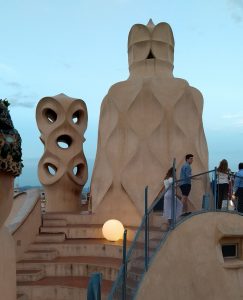 This place is also known as Casa Milà and was constructed between 1906 and 1912 by Antoni Gaudí. One has to see the interior of this building to fully appreciate it. We had been past this building many times but this was the first time we went inside. After struggling to describe it, I decided to provide a quote from lapedrera.com.
This place is also known as Casa Milà and was constructed between 1906 and 1912 by Antoni Gaudí. One has to see the interior of this building to fully appreciate it. We had been past this building many times but this was the first time we went inside. After struggling to describe it, I decided to provide a quote from lapedrera.com.
“Casa Milà was built as two apartment blocks with independent entrances linked by two large inner courtyards and a sinuous common façade that conveys the rhythm of the interior. The structure of the house is made of pillars and contains an open plan floor with large openings on the façade.”
Because of the inner courtyards, the roof does not have a big flat surface. It encircles the open space and has a series of steps going up and down with the sculptures rising up from the roof like sentries. As the daylight faded, they took on another dimension with lights from within. 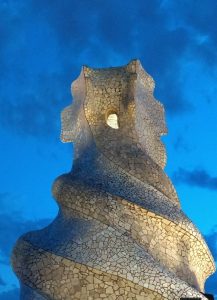 There was an almost full moon rising in the east that provided the perfect backdrop for a performance of “What A Little Moonlight Can Do” . https://youtu.be/R7VNrRS3Sv0
There was an almost full moon rising in the east that provided the perfect backdrop for a performance of “What A Little Moonlight Can Do” . https://youtu.be/R7VNrRS3Sv0
The interior of the building was fascinating also. We didn’t have much time to look around but did get a few shots.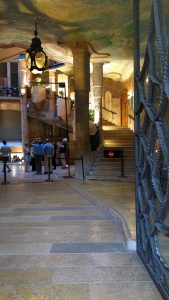
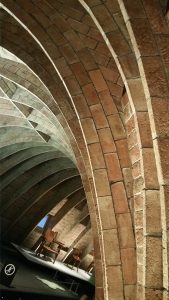
Sunday we went on a little road trip with our new friends Simone and Serafin to Sant Sadurni. This is the center of cava production in Spain. Cava is a sparkling wine, created by a process similar to that used by champagne makers in France. We visited 3 bodegas (translates numerous ways, but winery in this case) and toured one where Simone kindly translated for us. In short, they make wine and bottle it rather young, but add some sugar to it prior to capping (capped, not corked). The sugar ferments in the bottle – very similar process to bottle conditioning beer, for those homebrewers amongst the readers. Hundreds of thousands of these bottles are then laid on their sides for periods ranging from 9 months to 5 years or so.
When the cava is deemed ready for finishing, the bottles are – very slowly (transition requires 30 days) tipped upside down. Gravity deposits any remaining sediment in the cap. The bottle necks (and only the necks) are then frozen, the caps (with sediment) are removed, bottles set right side up and then corked. Voila! Cava!!
The bodega we toured also ran a restaurant where we stopped after the tour for a meal that was enough to last us a few days! Our friends told us it was traditional Catalunyan fare. First they brought a bottle of cava and another of sparkling water. They they brought a platter of tomatoes, garlic, toast and olive oil –
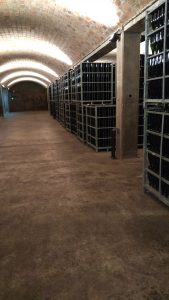
the idea is that you rub the tomatoes and garlic on the toast, sprinkle on some salt and douse it with olive oil. As soon as we got the toast fixed up, they brought more platters – 1) assorted charcuterie, 2) salad, 3) roasted eggplant and peppers, 4) and a cod dish. We had already set the wine aside as it was in the way of our plates, but with the addition of 4 platters of food, we really had to get down to business and eat, as there was no room left on the table for our own plates. We were making great headway on these platters and I was just about ready to call it an afternoon, when the waiter delivered the main course! A very large platter of lamb chops, sausage, roasted tomatoes and potatoes – plus a large bowl of white beans – beans with their own D.O. ( Denominaciones de Origen ) from Santa Pau (see last week’s post).
This was followed by a very light desert (sorbetto al limon) along with the mandatory espresso.
We decided to skip supper.